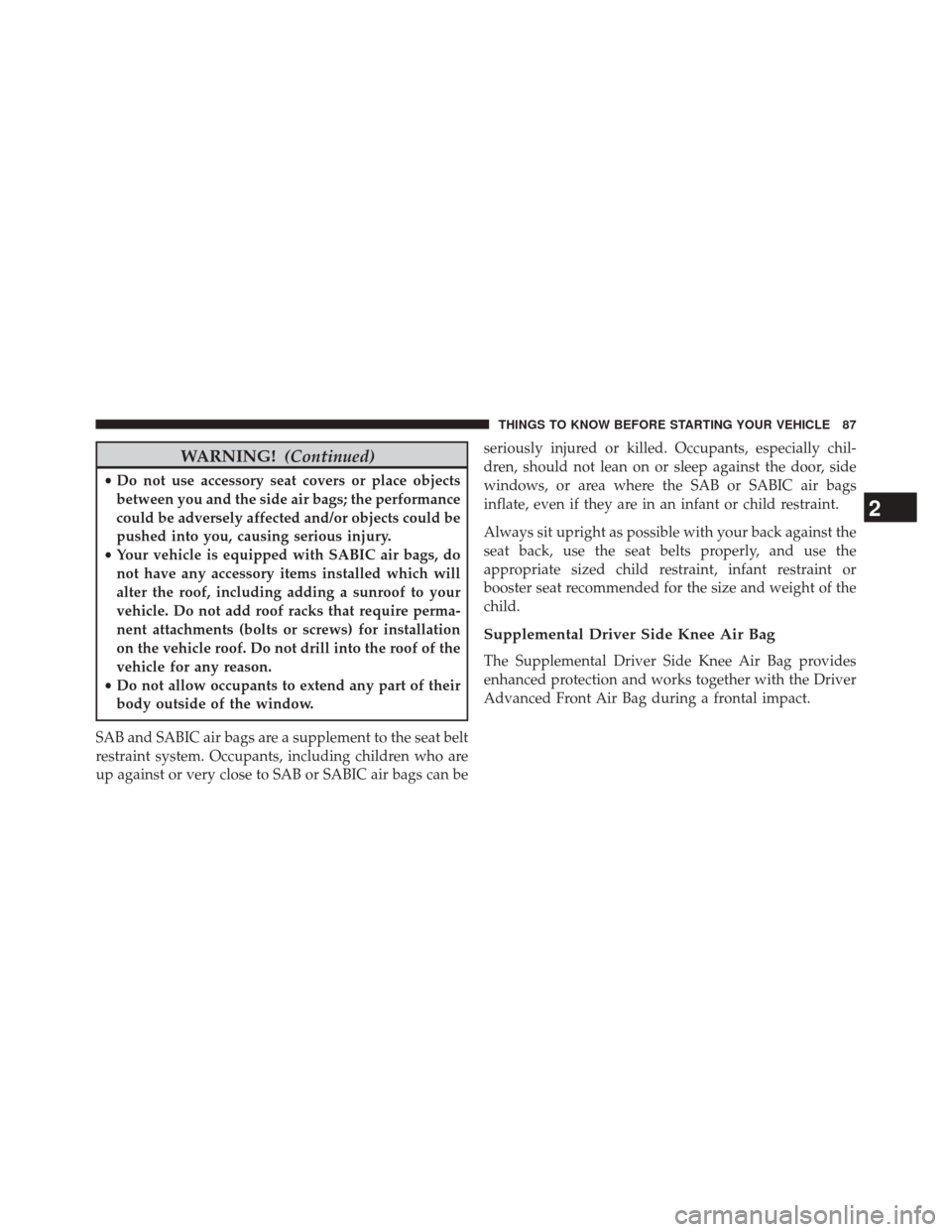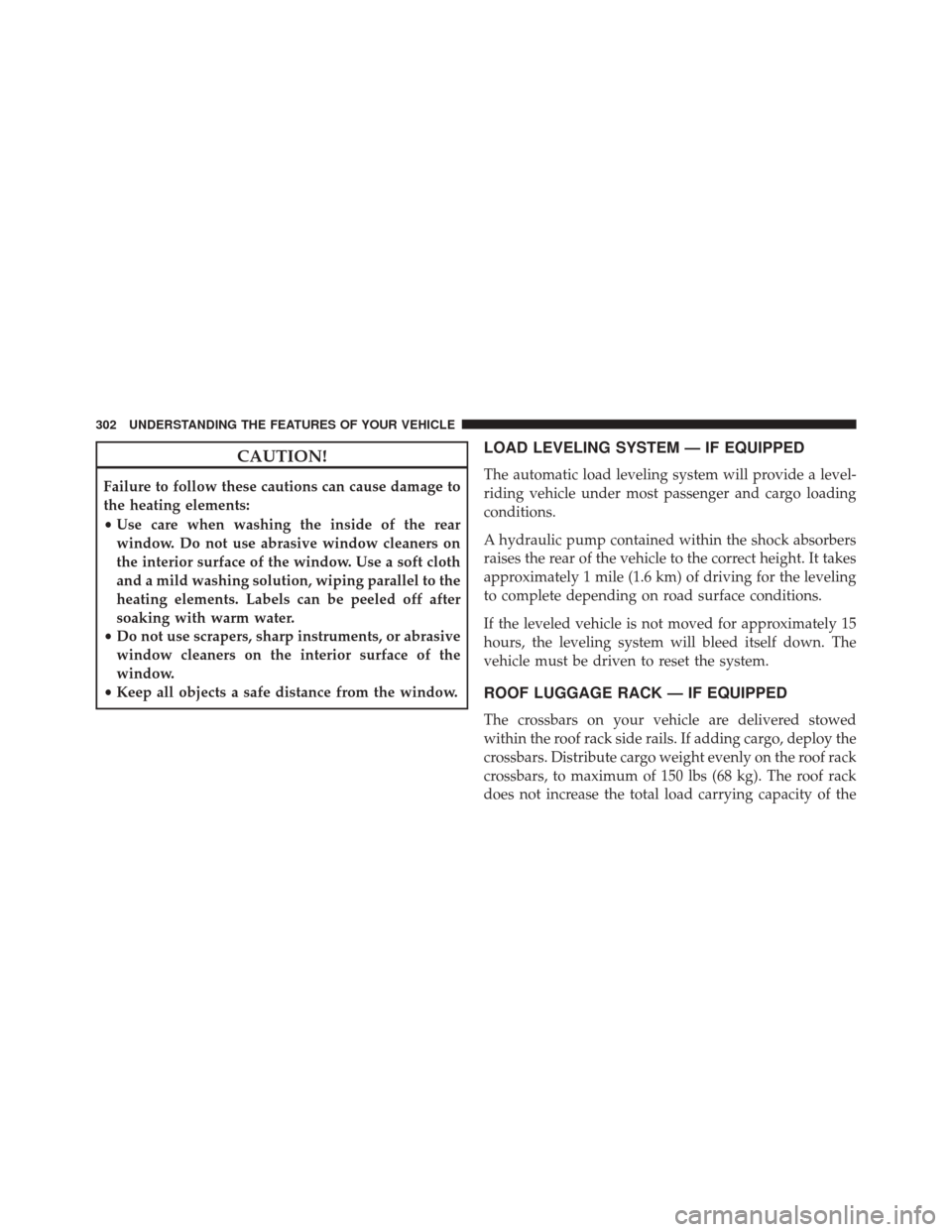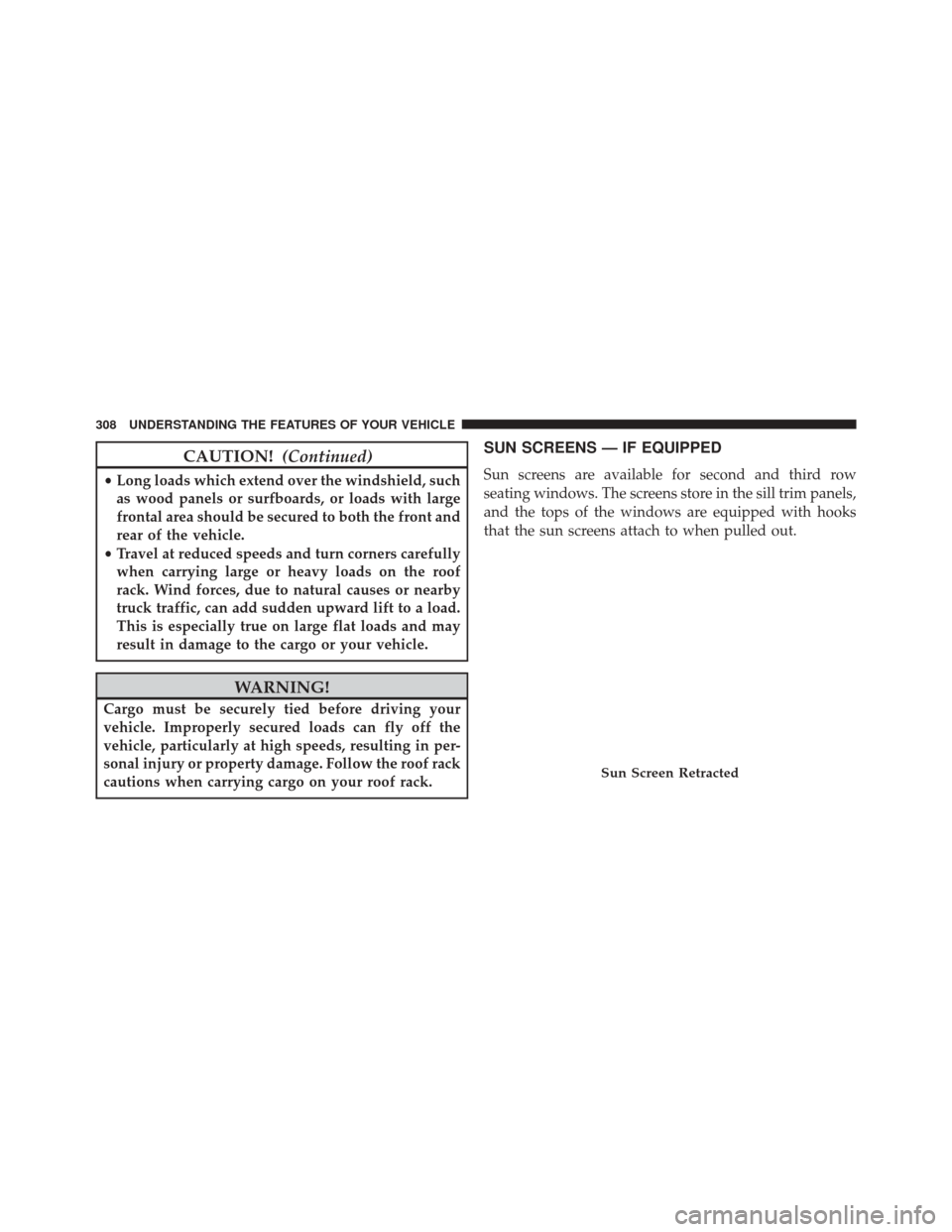Page 89 of 703

WARNING!(Continued)
•Do not use accessory seat covers or place objects
between you and the side air bags; the performance
could be adversely affected and/or objects could be
pushed into you, causing serious injury.
• Your vehicle is equipped with SABIC air bags, do
not have any accessory items installed which will
alter the roof, including adding a sunroof to your
vehicle. Do not add roof racks that require perma-
nent attachments (bolts or screws) for installation
on the vehicle roof. Do not drill into the roof of the
vehicle for any reason.
• Do not allow occupants to extend any part of their
body outside of the window.
SAB and SABIC air bags are a supplement to the seat belt
restraint system. Occupants, including children who are
up against or very close to SAB or SABIC air bags can be seriously injured or killed. Occupants, especially chil-
dren, should not lean on or sleep against the door, side
windows, or area where the SAB or SABIC air bags
inflate, even if they are in an infant or child restraint.
Always sit upright as possible with your back against the
seat back, use the seat belts properly, and use the
appropriate sized child restraint, infant restraint or
booster seat recommended for the size and weight of the
child.
Supplemental Driver Side Knee Air Bag
The Supplemental Driver Side Knee Air Bag provides
enhanced protection and works together with the Driver
Advanced Front Air Bag during a frontal impact.
2
THINGS TO KNOW BEFORE STARTING YOUR VEHICLE 87
Page 137 of 703
▫Coat Hooks ........................ .292
▫ Cargo Area Storage ....................292
� CONSOLE FEATURES ...................293
▫ Basic Console ....................... .293
▫ Premium Console — If Equipped ..........294
▫ Super Console — If Equipped .............298
� CARGO AREA FEATURES ................300
▫ Rechargeable Flashlight .................300 �
REAR WINDOW FEATURES ..............301
▫ Rear Window Defroster .................301
� LOAD LEVELING SYSTEM — IF EQUIPPED . .302
� ROOF LUGGAGE RACK — IF EQUIPPED . . . .302
▫ Deploying The Crossbars ................304
� SUN SCREENS — IF EQUIPPED ............308
3
UNDERSTANDING THE FEATURES OF YOUR VEHICLE 135
Page 304 of 703

CAUTION!
Failure to follow these cautions can cause damage to
the heating elements:
•Use care when washing the inside of the rear
window. Do not use abrasive window cleaners on
the interior surface of the window. Use a soft cloth
and a mild washing solution, wiping parallel to the
heating elements. Labels can be peeled off after
soaking with warm water.
• Do not use scrapers, sharp instruments, or abrasive
window cleaners on the interior surface of the
window.
• Keep all objects a safe distance from the window.
LOAD LEVELING SYSTEM — IF EQUIPPED
The automatic load leveling system will provide a level-
riding vehicle under most passenger and cargo loading
conditions.
A hydraulic pump contained within the shock absorbers
raises the rear of the vehicle to the correct height. It takes
approximately 1 mile (1.6 km) of driving for the leveling
to complete depending on road surface conditions.
If the leveled vehicle is not moved for approximately 15
hours, the leveling system will bleed itself down. The
vehicle must be driven to reset the system.
ROOF LUGGAGE RACK — IF EQUIPPED
The crossbars on your vehicle are delivered stowed
within the roof rack side rails. If adding cargo, deploy the
crossbars. Distribute cargo weight evenly on the roof rack
crossbars, to maximum of 150 lbs (68 kg). The roof rack
does not increase the total load carrying capacity of the
302 UNDERSTANDING THE FEATURES OF YOUR VEHICLE
Page 305 of 703
vehicle. Be sure the total load of cargo inside the vehicle
plus that on the external rack does not exceed the
maximum vehicle load capacity.The crossbars and side rails are designed to carry weight
on vehicles equipped with a luggage rack. The load must
not exceed 150 lbs (68 kg), and should be uniformly
distributed over the luggage rack crossbars.
NOTE:
•
Crossbars are error-proofed and cannot be deployed or
stowed in the incorrect positions.
• To help control wind noise, stow the crossbars in the
side rails when they are not in use.
Crossbar Stowed In Side Rail
3
UNDERSTANDING THE FEATURES OF YOUR VEHICLE 303
Page 309 of 703
NOTE:Load should always be secured to crossbars first,
with rail tie down loops used as additional securing
points if needed. Tie loops are intended as supplemen-
tary tie down points only. Do not use ratcheting mecha-
nisms with the tie loops.CAUTION!
• Check deployed crossbars frequently and retighten
thumb screws as necessary.
•
To avoid damage to the roof rack and vehicle, do not
exceed the maximum roof rack load capacity of 150 lb
(68 kg). Always distribute heavy loads as evenly as
possible and secure the load appropriately.
• To prevent damage to the roof of your vehicle, DO
NOT carry any loads on the roof rack without the
crossbars deployed.
• The load should be secured and placed on top of
the crossbars, not directly on the roof. If it is
necessary to place the load on the roof, place a
blanket or other protective layer between the load
and the roof surface.
(Continued)Rail Tie Loops
3
UNDERSTANDING THE FEATURES OF YOUR VEHICLE 307
Page 310 of 703

CAUTION!(Continued)
•Long loads which extend over the windshield, such
as wood panels or surfboards, or loads with large
frontal area should be secured to both the front and
rear of the vehicle.
• Travel at reduced speeds and turn corners carefully
when carrying large or heavy loads on the roof
rack. Wind forces, due to natural causes or nearby
truck traffic, can add sudden upward lift to a load.
This is especially true on large flat loads and may
result in damage to the cargo or your vehicle.
WARNING!
Cargo must be securely tied before driving your
vehicle. Improperly secured loads can fly off the
vehicle, particularly at high speeds, resulting in per-
sonal injury or property damage. Follow the roof rack
cautions when carrying cargo on your roof rack.
SUN SCREENS — IF EQUIPPED
Sun screens are available for second and third row
seating windows. The screens store in the sill trim panels,
and the tops of the windows are equipped with hooks
that the sun screens attach to when pulled out.
Sun Screen Retracted
308 UNDERSTANDING THE FEATURES OF YOUR VEHICLE
Page 381 of 703

Satellite Antenna
To ensure optimum reception, do not place items on the
roof around the rooftop antenna location. Metal objects
placed within the line of sight of the antenna will cause
decreased performance. Larger luggage items such as
bikes should be placed as far rearward as possible, within
the loading design of the rack. Do not place items directly
on or above the antenna.
Reception Quality
Satellite reception may be interrupted due to one of the
following reasons:
•The vehicle is parked in an underground parking
structure or under a physical obstacle.
• Dense tree coverage may interrupt reception in the
form of short audio mutes. •
Driving under wide bridges or along tall buildings can
cause intermittent reception.
• Placing objects over or too close to the antenna can
cause signal blockage.
Operating Instructions — Uconnect® (Satellite)
Mode
NOTE: The ignition switch must be in the ON/RUN or
ACC position to operate the radio.
SEEK Buttons
Press and release the SEEK buttons to search for the next
channel in Satellite mode. Press the right switch to seek
up and the left switch to seek down. The radio will
remain tuned to the new channel until you make another
selection. Holding either button will bypass channels
without stopping until you release it.
4
UNDERSTANDING YOUR INSTRUMENT PANEL 379
Page 692 of 703

Passing............................. .233
Reading ............................. .260
Rear Servicing ........................ .656
Rear Tail ............................ .656
Seat Belt Reminder ..................... .329
Security Alarm ........................ .327
Service .............................. .652
Service Engine Soon (Malfunction Indicator) . . . .324
Side Marker .......................... .655
SmartBeams .......................... .233
Tire Pressure Monitoring (TPMS) ............323
Traction Control ....................... .495
Turn Signal .......................... .127
Voltage ............................. .330
Warning (Instrument Cluster Description) ......319
Loading Vehicle ......................... .292
Capacities ........................... .546
Tires ............................... .506
Load Leveling System ..................... .302Locks
..................................37
Door .................................37
Lubrication, Body ........................ .624
Luggage Rack (Roof Rack) ...................302
Lug Nuts .............................. .575
Maintenance Free Battery ....................620
Maintenance Procedures ....................613
Maintenance Schedule ..................... .662
Malfunction Indicator Light (Check Engine) .......324
Manual, Service ......................... .676
Map/Reading Lights ...................... .260
Memory Feature (Memory Seat) ...............220
Memory Seat ........................... .139
Methanol .............................. .534
Mini-Trip Computer ...................... .345
Mirrors ............................... .136
Automatic Dimming .....................137
Electric
Remote ........................ .139
690 INDEX